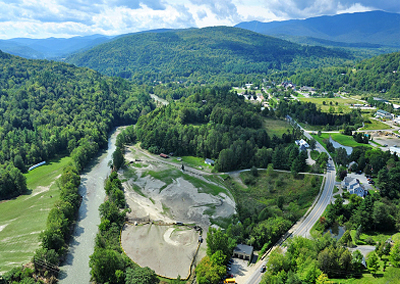The High Meadows Fund at the Vermont Community Foundation has awarded a team from the Mad River Valley (MRV) $60,000 to work together across the five-town watershed toward increasing flood resilience by tackling the challenges associated with stormwater runoff. This is one of six grants awarded throughout the state to groups working across municipal boundaries to find creative solutions that protect communities, land and water.
The grant, awarded to Friends of the Mad River, will lay the foundation for a long-term effort to proactively manage stormwater throughout the MRV. "Because stormwater runs across municipal boundaries, managing it better calls for collective planning and action at the watershed level," said Corrie Miller, Friends of the Mad River executive director. "I'm pleased that all five watershed towns are actively participating in our efforts to design a solution that works for this valley. Leaders share a general understanding that water connects each town and that we will accomplish more by working together."
The project stems from conversations at the Leahy Center Environmental Summit in March where a group of 20 citizens from all Valley towns identified stormwater runoff as one of the highest priority challenges in The Valley to strengthen resilience to future floods. "Improving stormwater management is a natural next step of the resilience efforts our community has embraced since Irene," said Joshua Schwartz, Mad River Valley Planning District executive director. "This project puts specific recommendations into practice. Because stormwater running off buildings, parking areas, roads and farms fills streams more quickly than in a natural setting, it exacerbates flooding and transports unhealthy pollutants. Valley residents saw better stormwater management as an opportunity to reduce flooding, and damage from it, and to make the Mad River cleaner," he added.
"From my own observations during and after Tropical Storm Irene, I believe the cause of damage was more complex than just Mad River flooding," remarked John Hoogenboom, Moretown Select Board vice chair and Moretown's incident commander in the wake of Irene. "Rather, the cause was watershedwide, primarily from upland runoff. Everything we do across The Valley in building our roads and properties contributes to channeling this runoff directly into the Mad River," he continued.
A resilient Mad River Valley is less vulnerable to – and smoothly bounces back from – natural and climate-related disasters and from the risks they pose to our economy, environment and social well-being. "Having been involved with a mountainous watershed from a business perspective, I have always wondered if there wasn't a more efficient, flood-resilient and less costly way to disperse precipitation than our current practices," said Bob Ackland, Warren Select Board and Mad River Valley Planning Committee steering committee member and former president of Sugarbush Resort. "I am excited that the High Meadows grant secured by the hard work of Friends of the Mad River will provide the means to begin a fruitful discussion on this subject, soliciting input to policy decisions as well as developing best practices within the watershed," Ackland said.
A task force of official municipal representatives and other interested community members will serve as the nucleus of the planning effort, ensuring that the resulting program meets the community's objectives. The task force will educate and engage the community in the planning process, consider research results and public input, recommend a structure and scope for a future stormwater management program and exchange information with municipal boards via official town representatives. "The stormwater management program the task force develops over the course of this project will have a direct and positive impact on Fayston," said Jared Cadwell, Fayston Select Board chair and a member of the Mad River Valley Planning District steering committee.
"Our road network is primarily through steep terrain that poses difficult ditching and roadway maintenance challenges. This project will greatly assist the town in improving its maintenance and lessening the impact of stormwater from roads on our Mad River watershed," Cadwell said.
Friends of the Mad River, organizational partners, paid professional consultants (engineers, hydrologists, planners) and others will support the task force in its work. "The Mad River Valley Chamber of Commerce looks forward to helping include businesses in the discussion about flood resilience. We hope to engage the business community so that the same energy that has gone toward flood relief can be directed toward flood preparedness," said Lisa Davis, executive director.
"As we have seen in recent years, the impacts of flooding can be quite severe, threatening public safety, damaging roads and bridges, disrupting businesses and displacing people from their homes," remarked Kari Dolan, Waitsfield Select Board and Mad River Valley Planning District steering committee member.
"Even recovering from small more localized floods can be costly. This grant will certainly help Waitsfield and other Valley towns improve resilience to future flooding, maintain the Mad River as the great community asset that it is and help us save money in the long run. We thank High Meadows for seeing the value in this effort and look forward to working with the Friends and our neighbors as part of this important project," Dolan added.
For more information or to get involved in this project, contact Miller at Friends of the Mad River or visit www.FriendsOfTheMadRiver.org.







